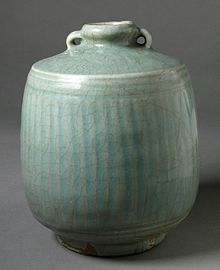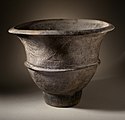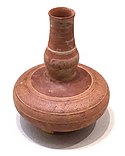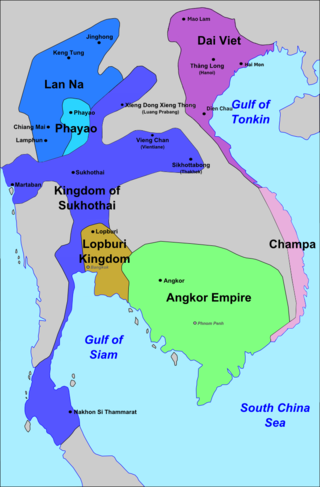
The Sukhothai Kingdom or the Northern Cities was a post-classical Thai kingdom (mandala) in Mainland Southeast Asia surrounding the ancient capital city of Sukhothai in present-day north-central Thailand. The kingdom was founded by Si Inthrathit in 1238 and existed as an independent polity until 1438, when it fell under the influence of the neighboring Ayutthaya after the death of Borommapan.
Lao ceramics refers to ceramic art and pottery designed or produced as a form of Lao art. The tradition of Lao ceramics dates back to the third millennium BCE. Pottery and ceramics were an essential part of the trade between Laos and its neighbours.

Sukhothai is one of Thailand's seventy-six provinces (changwat) lies in lower northern Thailand. Neighboring provinces are Phrae, Uttaradit, Phitsanulok, Kamphaeng Phet, Tak, and Lampang. Sukhothai can be translated as 'dawn of happiness'.
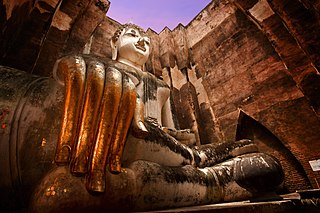
Sukhothai Historical Park covers the ruins of Sukhothai, literally 'dawn of happiness', capital of the Sukhothai Kingdom in the 13th and 14th centuries, in north central Thailand. It is near the city of Sukhothai, capital of Sukhothai Province.

Ram Khamhaeng or Pho Khun Ram Khamhaeng Maharat, also spelled Ramkhamhaeng, was the third king of the Phra Ruang Dynasty, ruling the Sukhothai Kingdom from 1279 to 1298, during its most prosperous era.

Stoneware is a broad term for pottery fired at a relatively high temperature. A modern definition is a vitreous or semi-vitreous ceramic made primarily from stoneware clay or non-refractory fire clay. End applications include tableware, decorative ware such as vases.

Pottery and porcelain, is one of the oldest Japanese crafts and art forms, dating back to the Neolithic period. Kilns have produced earthenware, pottery, stoneware, glazed pottery, glazed stoneware, porcelain, and blue-and-white ware. Japan has an exceptionally long and successful history of ceramic production. Earthenwares were made as early as the Jōmon period, giving Japan one of the oldest ceramic traditions in the world. Japan is further distinguished by the unusual esteem that ceramics hold within its artistic tradition, owing to the enduring popularity of the tea ceremony.

Celadon is a term for pottery denoting both wares glazed in the jade green celadon color, also known as greenware or "green ware", and a type of transparent glaze, often with small cracks, that was first used on greenware, but later used on other porcelains. Celadon originated in China, though the term is purely European, and notable kilns such as the Longquan kiln in Zhejiang province are renowned for their celadon glazes. Celadon production later spread to other parts of East Asia, such as Japan and Korea as well as Southeast Asian countries, such as Thailand. Eventually, European potteries produced some pieces, but it was never a major element there. Finer pieces are in porcelain, but both the color and the glaze can be produced in stoneware and earthenware. Most of the earlier Longquan celadon is on the border of stoneware and porcelain, meeting the Chinese but not the European definitions of porcelain.

Thai art refers to a diverse range of art forms created in Thailand from prehistoric times to the present day, including architecture, sculpture, painting, textiles, decorative arts, crafts, ceramics, and more. While Buddhism has played a significant role in Thai art, with many sculptures and paintings depicting Buddha images and religious themes, nature, including flora and fauna, as well as mythical creatures, has been a major inspiration for Thai art, with colorful motifs appearing in various types of art forms. In contemporary Thai art, traditional works remain significant and continue to influence artists' concepts.

Korean ceramic history begins with the oldest earthenware from around 8000 BC. Throughout the history, the Korean peninsula has been home to lively, innovative, and sophisticated art making. Long periods of stability have allowed for the establishment of spiritual traditions, and artisan technologies specific to the region. Korean ceramics in Neolithic period have a unique geometric patterns of sunshine, or it is decorated with twists. In Southern part of Korea, Mumun pottery were popular. Mumun togi used specific minerals to make colors of red and black. Korean pottery developed a distinct style of its own, with its own shapes, such as the moon jar or Buncheong sagi which is a new form between earthenware and porcelain, white clay inlay celadon of Goryeo, and later styles like minimalism that represents Korean Joseon philosophers' idea. Many talented Korean potters were captured and brought to Japan during the invasions of Korea, where they heavily contributed to advancing Japanese pottery. Arita ware, founded by Yi Sam-pyeong opened a new era of porcelain in Japan. Another Japanese representative porcelain, Satsuma ware was also founded by Dang-gil Shim and Pyeong-ui Park. 14th generation of Su-kwan Shim have been using the same name to his grandfather and father to honor they are originally Korean, 14th Su-kwan Shim is honorable citizen of Namwon, Korea.

Maiolica is tin-glazed pottery decorated in colours on a white background. The most renowned Italian maiolica is from the Renaissance period. These works were known as istoriato wares when depicting historical and mythical scenes. By the late 15th century, multiple locations, mainly in northern and central Italy, were producing sophisticated pieces for a luxury market in Italy and beyond. In France, maiolica developed as faience, in the Netherlands and England as delftware, and in Spain as talavera. In English, the spelling was anglicised to majolica, but the pronunciation usually preserved the vowel with an i as in kite.
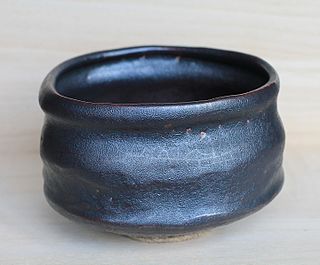
Oribe ware is a style of Japanese pottery that first appeared in the sixteenth century. It is a type of Japanese stoneware recognized by its freely-applied glaze as well as its dramatic visual departure from the more somber, monochrome shapes and vessels common in Raku ware of the time. The ceramics were often asymmetrical, embracing the eccentricity of randomized shapes. Deformed shapes were not at all uncommon. These shapes were achieved through the implementation of moulding as a technique, as opposed to working on a potter’s wheel. Sometimes, bowls were so deformed that they became difficult to use – whisking tea could even become a difficult task.

Chinese ceramics show a continuous development since pre-dynastic times and are one of the most significant forms of Chinese art and ceramics globally. The first pottery was made during the Palaeolithic era. Chinese ceramics range from construction materials such as bricks and tiles, to hand-built pottery vessels fired in bonfires or kilns, to the sophisticated Chinese porcelain wares made for the imperial court and for export. Porcelain was a Chinese invention and is so identified with China that it is still called "china" in everyday English usage.

Vietnamese ceramics refers to ceramic art and pottery as a form of Vietnamese art and industry. Vietnamese pottery and ceramics has a long history spanning back to thousands of years ago, including long before Chinese domination, as archeological evidence supports.
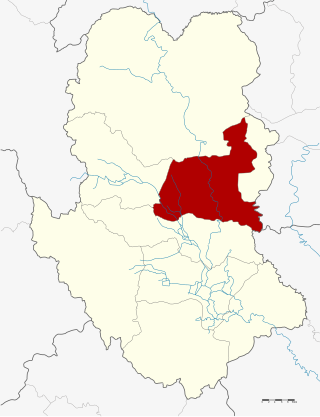
Sawankhalok is a district (amphoe) in the northern part of Sukhothai province, in the lower north of Thailand.

The Si Satchanalai Historical Park is a historical park in Si Satchanalai district, Sukhothai Province, northern Thailand. The park covers the ruins of Si Satchanalai and Chaliang. Si Satchanalai, which literally means "City of good people", was founded in 1250 as the second center of the Sukhothai Kingdom and as a residence of the crown prince in the 13th and 14th centuries.

Pha Mueang was a Thai nobleman and general who was the Lord of Rad and played a significant role in the founding of the Sukhothai Kingdom.

Ceramic art is art made from ceramic materials, including clay. It may take varied forms, including artistic pottery, including tableware, tiles, figurines and other sculpture. As one of the plastic arts, ceramic art is a visual art. While some ceramics are considered fine art, such as pottery or sculpture, most are considered to be decorative, industrial or applied art objects. Ceramic art can be created by one person or by a group, in a pottery or a ceramic factory with a group designing and manufacturing the artware.
Sangkhalok ceramic wares are ancient Thai traditional ceramic wear specifically derived from Sukhothai kingdom period. Decorated with traditional motifs, and fired at 1,150-1,280 °C, made into pottery, jar, teapot, spoon, and ceramic doll. The technique of manufacturing and firing dates from the beginning of Sukhothai period (1238-1351) through the end of Ayutthaya kingdom according to evidence of ancient kiln that appear around Si Satchanalai District in Phranakhon Sukhothai province, Thailand.
Mueang Bang Khlang is a tambon (sub-district) of Sawankhalok District, Sukhothai Province, upper central Thailand.
